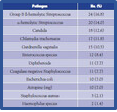The role of modified vaginal microbiota on postoperative bleeding following large loop excision of the transformation zone (LLETZ)
Vloga spremenjene mikrobiote nožnice na pojavnost pooperativne krvavitve po eksciziji transformacijske cone z električno zanko (LLETZ)
DOI:
https://doi.org/10.18690/actabiomed.210Keywords:
genital pathogens, Chlamydia trachomatis, large loop excision of the transformation zone (LLETZ), postoperative bleedingAbstract
Purpose: To evaluate the effect of a modified vaginal microbiota containing various vaginal pathogens and Chlamydia trachomatis on postoperative bleeding following large loop excision of the transformation zone (LLETZ) of the uterine cervix.
Methods: We performed a retrospective analysis of patients with cervical intraepithelial neoplasia (CIN) who underwent LLETZ at the Clinic for Gynaecology and Obstetrics, UMC Maribor, between 1993 and 2005. Cervical swabs were collected before the procedure to evaluate the presence of Chlamydia trachomatis and other genital pathogens. After the procedure, the occurrence and severity of postoperative bleeding was evaluated.
Results: A total of 192 patients were recruited. A modified vaginal microbiota containing various vaginal pathogens and Chlamydia trachomatis was present in 5.2% of patients. The most frequently isolated groups of vaginal pathogens were group B streptococcus and Candida species. The occurrence of postoperative bleeding after LLETZ did not differ significantly when compared between groups with or without a modified vaginal microbiota containing various vaginal pathogens and Chlamydia trachomatis (50.0% vs. 37.9%, p = 0.512).
Conclusion: Patients with cervical intraepithelial neoplasia (CIN) commonly exhibit a modified vaginal microbiota containing various vaginal pathogens and Chlamydia trachomatis. However, this is not an important risk factor for postoperative bleeding after LLETZ.
Downloads

Downloads
Published
Issue
Section
License
Copyright (c) 2021 Acta Medico-Biotechnica

This work is licensed under a Creative Commons Attribution 4.0 International License.